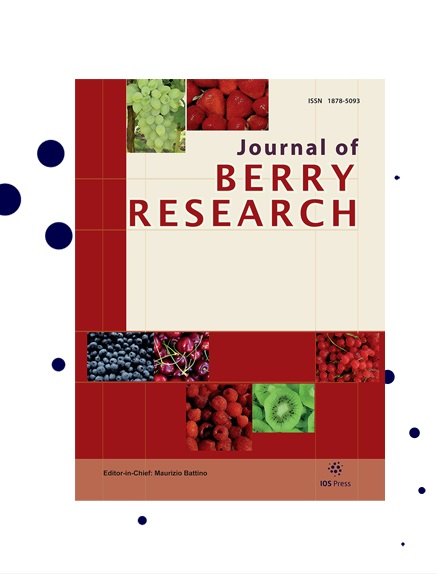不同灌溉间隔及氨基酸和腐殖酸叶面施用对彩色遮荫网下草莓生理特性的影响
IF 1.4
4区 农林科学
Q3 PLANT SCIENCES
引用次数: 0
摘要
背景:草莓是一种重要的商品作物,提高产量和品质是当务之急。目的:研究不同灌溉间隔下彩色网和叶面施用氨基酸对草莓生理特性的影响。方法:本研究采用随机完全区组设计的析因实验,包括4个水平的彩网(无网、绿色、红色和黄色网)、4个水平(对照、腐殖酸、谷氨酰胺和精氨酸)的有机酸和3个水平的灌溉间隔(2、4和6天),伊朗。结果:黄网的叶片数、茎重、叶绿素和类胡萝卜素含量最高。无网处理、绿色网处理和红色网处理的果实产量、花青素和类黄酮含量最高。有机酸效应数据显示,谷氨酰胺处理的植物产量最高,腐殖酸处理的植物花青素和类胡萝卜素含量最高,精氨酸处理的植株维生素C含量最高。灌溉间隔6天造成叶片数、花果数、地上部重量、果实产量和类胡萝卜素含量最低。“网×有机酸×灌溉”三边效应数据显示,“绿网×谷氨酰胺×4天”的花数和产量最高,“绿网×腐殖酸×2天”的花青素含量最高,“绿网×对照×6天”的叶绿素含量最高。黄网×对照×2天处理黄酮含量最高。结论:彩色网的应用为草莓提供了最佳的营养生长和生殖生长。本文章由计算机程序翻译,如有差异,请以英文原文为准。
Effects of irrigation intervals and foliar application of amino acids and humic acid on the physiological traits of strawberries under colored shading nets
BACKGROUND: The strawberry is an important commercial crop, the improvement of its yield and quality is an imperative task. OBJECTIVE: The present research aimed to study the effect of colored netting and foliar application of amino acids on the physiological characteristics of strawberries subjected to different irrigation intervals. METHODS: The study was carried out as a factorial experiment based on a randomized complete block design with three factors including colored net at 4 levels (no netting, green, red, and yellow netting), organic acids at 4 levels (control, humic acid, glutamine, and arginine), and three levels of irrigation intervals (2, 4, and 6 days) in the greenhouse of Lahijan Agricultural Research Station, Iran. RESULTS: The results showed that the highest leaf number, shoot weight, chlorophyll and carotenoid content were related to yellow netting. The highest fruit yield, anthocyanins, and flavonoids were observed in the treatments of no-netting, green netting, and red netting, respectively. Data for the effect of organic acids showed that the glutamine-treated plants exhibited the highest yield, the humic acid-treated plants displayed the highest anthocyanin and carotenoid content, and the arginine-treated plants demonstrated the highest vitamin C content. The irrigation interval of 6 days caused to the lowest leaf number, flower and fruit number, shoot weight, fruit yield, and carotenoid content. Data for the trilateral effect of ‘netting×organic acid×irrigation’ showed that the highest flower number and fruit yield were obtained from ‘green netting×glutamine×4 days’, the highest anthocyanin content was obtained from ‘green netting×humic acid×2 days’, and the highest chlorophyll content was obtained from ‘green netting×control×6 days’. The treatment of ‘yellow netting×control×2 days’ was related to the highest flavonoid content. CONCLUSIONS: The application of colored nets provides the strawberry with more optimal vegetative and reproductive growth.
求助全文
通过发布文献求助,成功后即可免费获取论文全文。
去求助
来源期刊

Journal of Berry Research
Biochemistry, Genetics and Molecular Biology-Biochemistry
CiteScore
3.50
自引率
11.80%
发文量
21
期刊介绍:
The main objective of the Journal of Berry Research is to improve the knowledge about quality and production of berries to benefit health of the consumers and maintain profitable production using sustainable systems. The objective will be achieved by focusing on four main areas of research and development:
From genetics to variety evaluation
Nursery production systems and plant quality control
Plant physiology, biochemistry and molecular biology, as well as cultural management
Health for the consumer: components and factors affecting berries'' nutritional value
Specifically, the journal will cover berries (strawberry, raspberry, blackberry, blueberry, cranberry currants, etc.), as well as grapes and small soft fruit in general (e.g., kiwi fruit). It will publish research results covering all areas of plant breeding, including plant genetics, genomics, functional genomics, proteomics and metabolomics, plant physiology, plant pathology and plant development, as well as results dealing with the chemistry and biochemistry of bioactive compounds contained in such fruits and their possible role in human health. Contributions detailing possible pharmacological, medical or therapeutic use or dietary significance will be welcomed in addition to studies regarding biosafety issues of genetically modified plants.
 求助内容:
求助内容: 应助结果提醒方式:
应助结果提醒方式:


